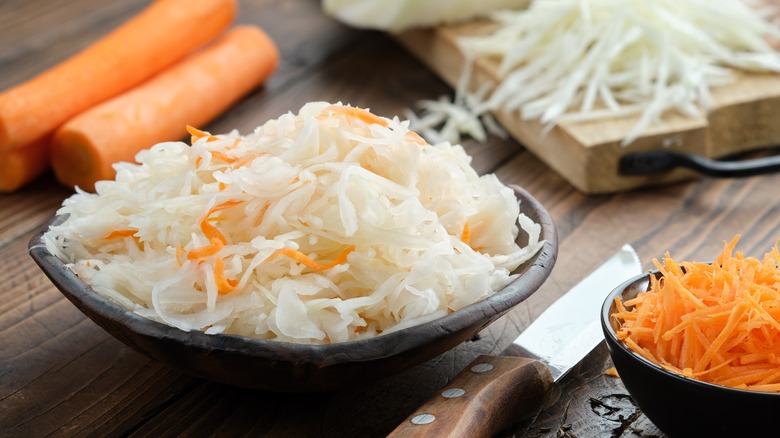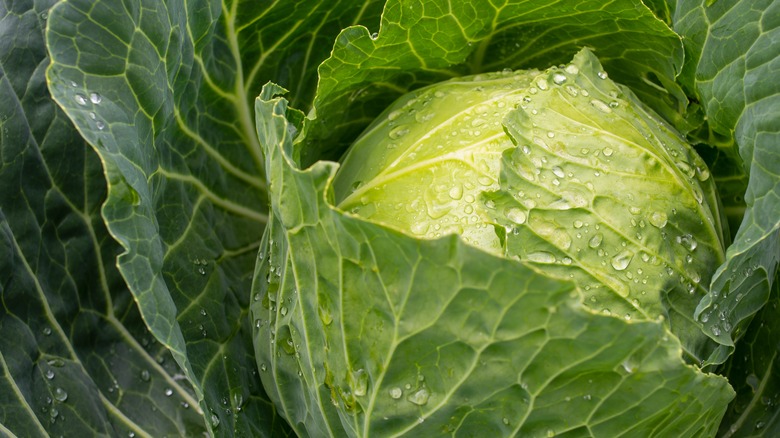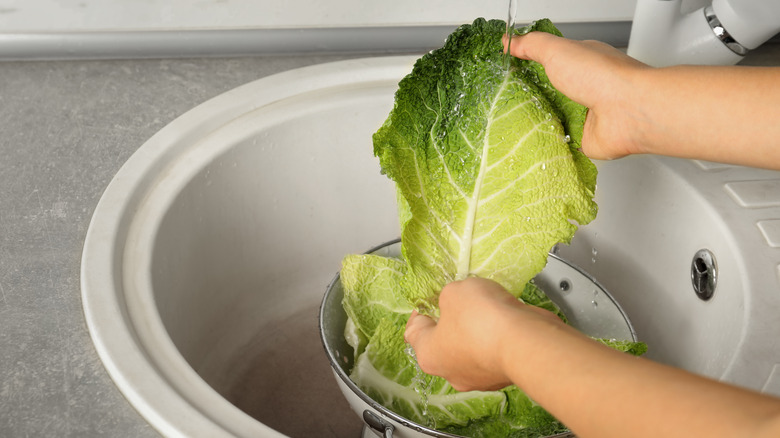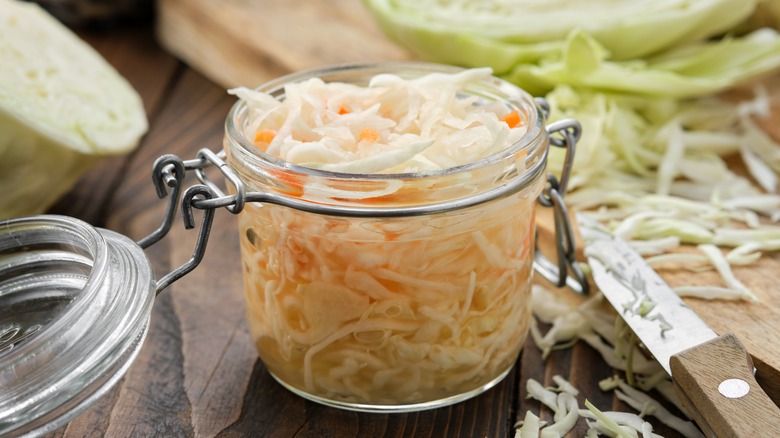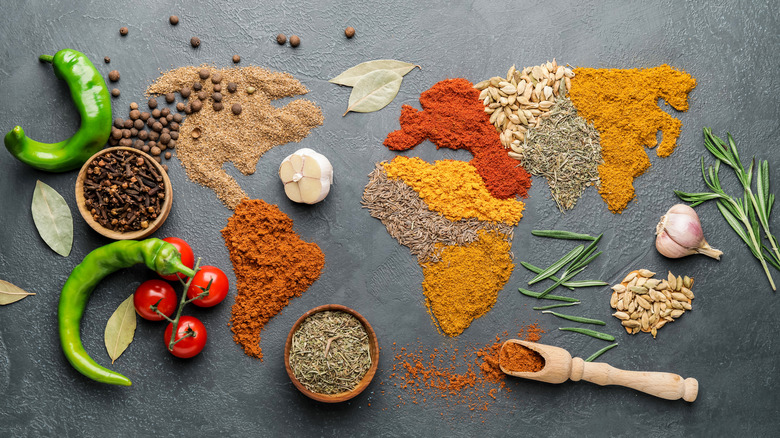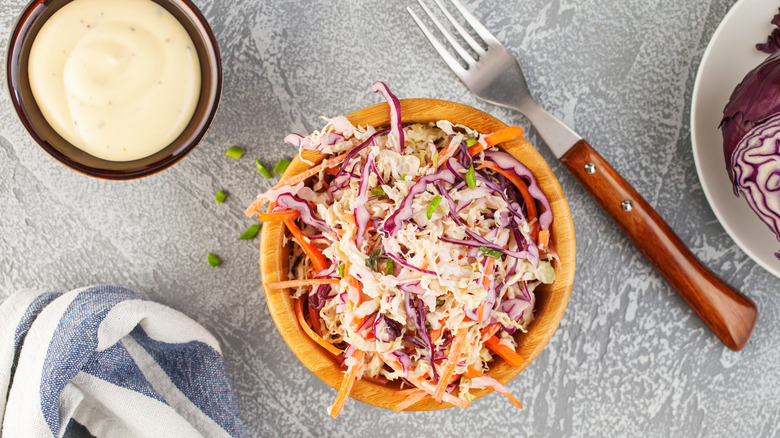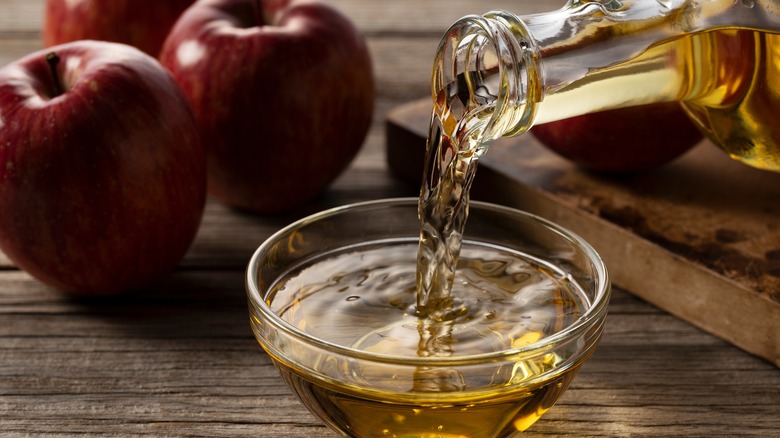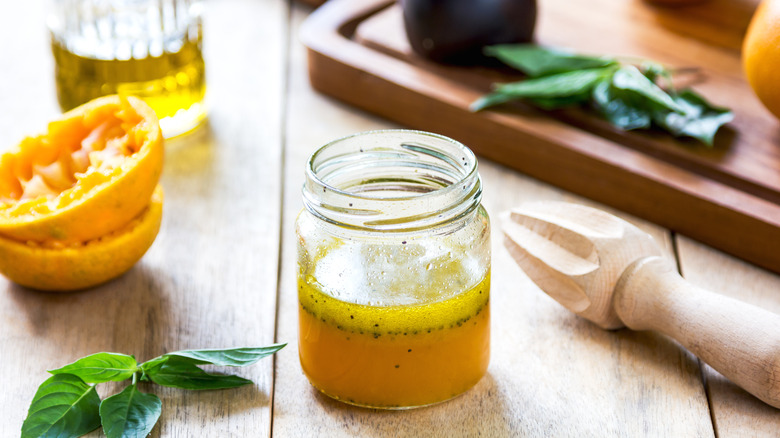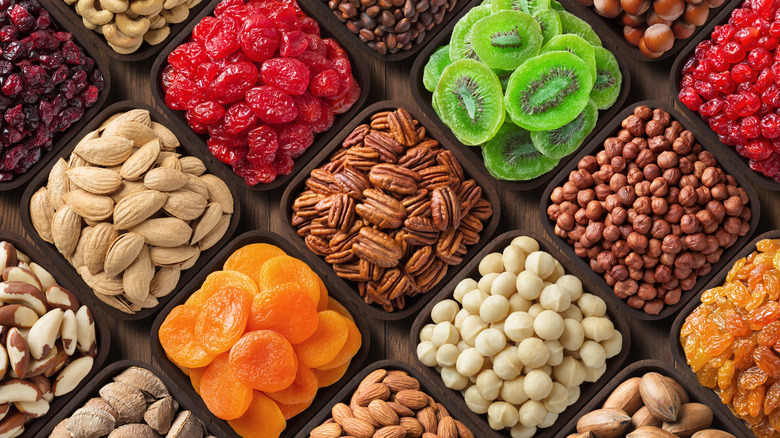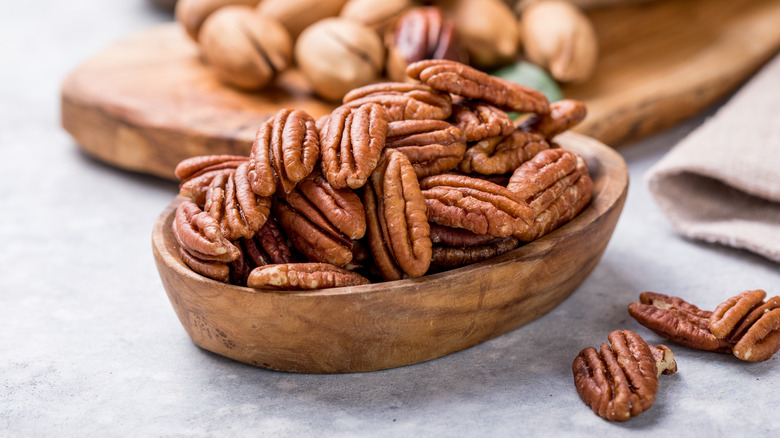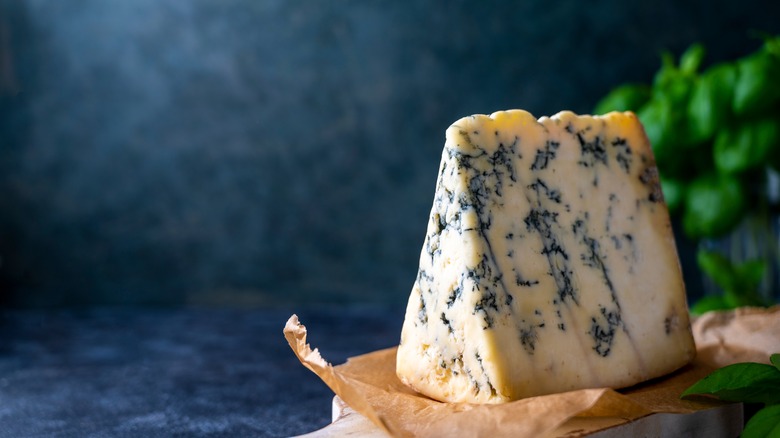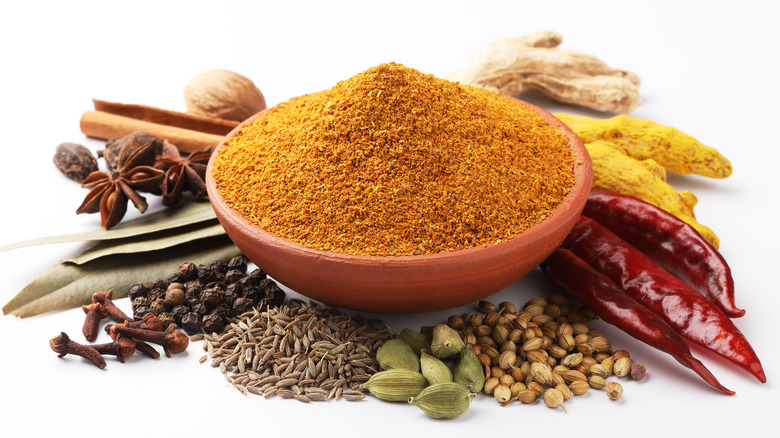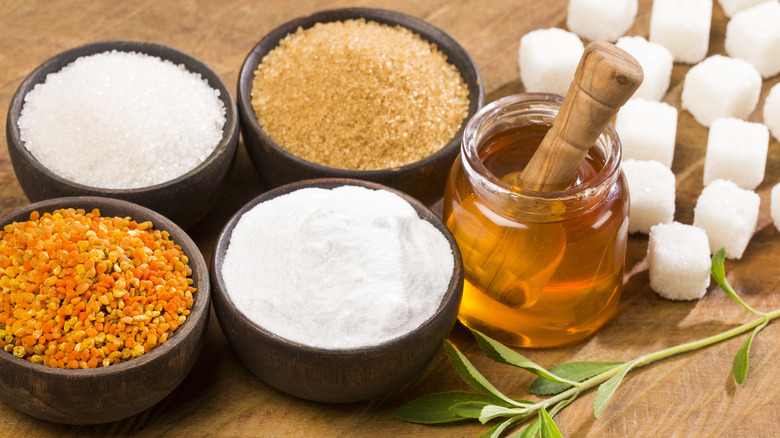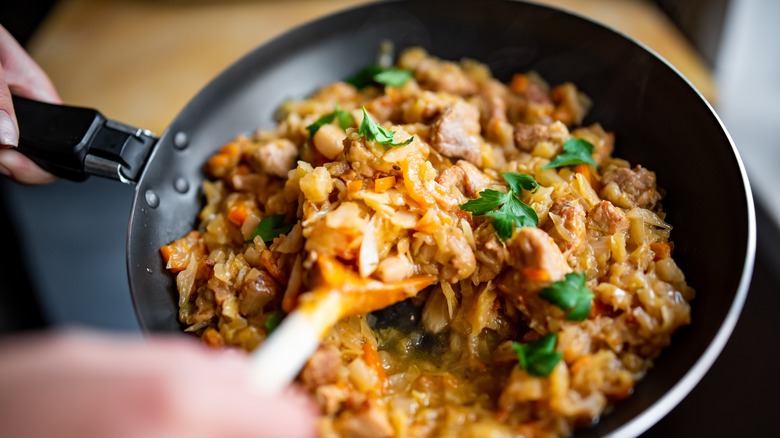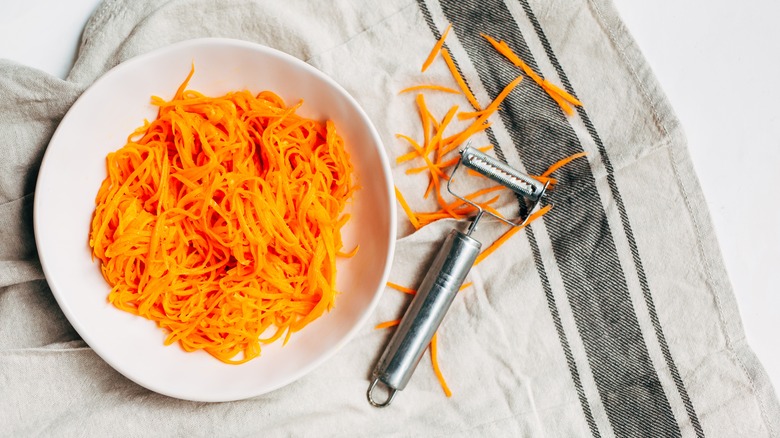14 Ways To Boost The Flavor Of Your Coleslaw
Creamy, crunchy, flavorful coleslaw — what's not to love about this classic staple? This dish makes frequent appearances as a traditional picnic side served with anything from barbecued meat to sandwiches. Despite its ubiquitousness at American cookouts, similar cabbage recipes are common in many cuisines worldwide, and they're served both cold and warm. In fact, the word coleslaw comes from the Dutch "koolsla," with "kool" meaning cabbage and "sla" meaning salad.
It's generally agreed that the principal ingredient of this side dish is cabbage and that a satisfying crunch is a defining feature. If a crisp vegetable is the minimum requirement, then the sky is the limit for creative interpretations that boost flavor and add unique interest to the traditional version. Whether combining specific vegetables, spicing up the dressing, or taking inspiration from world cuisines like Asian and Mexican food, there are easy ways to use seasonings and ingredients to take coleslaw to new heights.
For freshness and variety, avoid prepackaged veggies
It's tempting to grab a bag of prepackaged coleslaw for the convenience of having the vegetables shredded and ready to go. If saving time is your priority, there's nothing wrong with just dressing the veggies and digging in. However, these mixes usually only contain shredded cabbage and maybe carrots, and the freshness of the produce might be questionable. Choosing your own combination of vegetables and chopping them yourself can boost the flavor of your coleslaw by giving you a greater range of options to mix and match.
While prepackaged coleslaw is generally made with green cabbage, there are actually 13 other varieties of the vegetable that can boost your side dish. Mix green and red cabbage for a nice, pretty color, or add those with interesting textures like Tuscan cabbage or kale. Coleslaw is best when it's crunchy and robust, so any firm veggies, particularly root vegetables, are excellent for this dish. Celery, brussels sprouts, beets, carrots, and radishes also work well. For a greater boost, add produce with unique flavors like fennel or celery root, and don't be shy with aromatics like onions (including red onions for color), scallions, and leeks. This kind of variety will not only create greater flavor combinations and improve the coleslaw's taste but will boost its appearance as well, making it even more likely to make mouths water.
Salt and drain the cabbage first to keep it crisp
No one looking forward to crispy coleslaw wants to bite into a soggy mess of wet cabbage instead. The veggie contains up to 93% water, so adding condiments and salt will cause water to leach out of its leaves, making the dish watery and reducing the impact of the dressing's flavor. The liquid will also make the cabbage softer as it sits in the final coleslaw mix, especially if you make it ahead of time.
Luckily, there's an easy trick to prevent the vegetable from getting soggy and preserve flavor. After cutting or shredding the cabbage, place the pieces in a colander and sprinkle a little salt over it. Toss the leaves to evenly distribute the seasoning, put a bowl beneath the vessel, and let them sit for one to four hours; the salt will pull the water out of the cabbage and keep it crunchy. Then, dry the pieces with a kitchen towel. Just remember to go easy on the salt while seasoning the dressing to compensate for the added sodium on the leaves.
If the wait time has you considering making something else instead, never fear. You can skip the wait and microwave your coleslaw to keep it crispy. Sprinkle a little sugar and salt on the cabbage and microwave it for three minutes in a bowl. Let the leaves sit for five minutes, and then put them on a towel to squeeze out the extra water.
Marinate coleslaw ahead of time for added flavor
Coleslaw is usually made with firm produce like root vegetables, which are more robust and can withstand sitting in dressing without getting mushy. The dish earns extra points because its hardiness makes it ideal for making ahead of time, which will develop the flavor even more as the veggies marinate in the dressing and the ingredients mingle. And let's face it: tasting great when made ahead makes this side a winner when you're trying to prepare five dishes for your cookout before the guests arrive.
For the best coleslaw, marinate it in the fridge for at least two hours up to four days before serving. The homemade mix can be safely stored in the refrigerator for three to four days (via Does It Go Bad), so there is some flexibility here. However, even though the veggies are sturdy, they will get a little softer the longer they sit in the dressing, so for lovers of maximum crunch, aim for the shorter end of the time frame — about two hours.
Even if you don't make the dish early, one way to give your coleslaw more flavor is to make the dressing ahead of time, letting it sit in the fridge for at least one hour to let the ingredients blend before you mix it with the vegetables.
Choose global cuisines as inspiration for an unexpected flavor profile
Traditionally, coleslaw is made with shredded cabbage and a mayo and vinegar dressing, but many flavor profiles can bring the end result up a notch. Choosing a theme and using the appropriate ingredients will bring tastes from around the world to this humble dish, creating something both tasty and unexpected. For example, the dressing for this Asian-inspired coleslaw recipe is made with rice vinegar, soy sauce, garlic, lime, honey, and olive oil. Red and green cabbage, carrots, and bell pepper make it colorful and crunchy, and a Serrano pepper adds a kick.
Grab a map as inspiration. Make a Greek coleslaw with oregano and feta, or substitute Greek yogurt for mayo. A Southwest variety features cherry tomatoes, corn, and flavorings such as chili powder, cumin, and freshly chopped cilantro. Go Italian by adding thinly sliced fennel, parsley, and orange slices, or make a Creole version with Creole mustard and seasoning in an otherwise traditional mayo dressing. While a little different from raw coleslaw, fermented cabbage side dishes are popular worldwide, including curtido, a Salvadoran cabbage slaw.
Take your homemade dressing to new heights
Classic coleslaw dressings can vary a little, but most feature a base of mayonnaise with vinegar, Dijon mustard, salt and pepper, and perhaps celery seed and sugar as well. For those seeking maximum flavor, this is just the beginning. Unless you prefer it mild, add something stronger to the dressing. Try blending in chili pepper, ginger, capers, miso, lime juice, or preserved pepperoncini. Sweet onions like Vidalias can be pulverized and added to the mix; unlike pieces of the raw vegetable, the broken-down version will add a pleasing flavor evenly throughout the dish.
Instead of the traditional sugar, other kinds of sweeteners like honey, maple syrup, agave nectar, and even molasses can be used to lend a gentle sweetness to the overall dish. This basic coleslaw dressing with honey and rice wine vinegar will do the trick; the vinegar is present in most versions of the side anyway, and the tang of the ingredient plus the sweetness of something like honey is an excellent flavor combination.
If you're not a mayo fan, substitute Greek yogurt or sour cream for some or all of the mayonnaise in the recipe. Those on a vegan diet can make a creamy base with blended cashews or tahini instead for a creamier and slightly nutty flavor.
Don't use too much vinegar
Most coleslaw dressings call for vinegar; some prefer red wine vinegar, while others swear by apple cider, white wine, or rice wine vinegar. Each variety of the ingredient will add a slightly different touch, but more important is the quantity. Use caution, and don't add too much; it's easy to overdo it with unpalatable results.
If you do add too much and your coleslaw tastes unpleasant or acidic, there are some ways you can balance it out. If you have extra, add more cabbage or veggies so the dressing will spread out more. If you haven't added the condiment mix yet, add more of the other ingredients to compensate. Too much vinegar can also be neutralized by adding sugar to counteract the acidity, including hot spices like cayenne pepper for a flavor distraction, or mixing in a fat like olive oil or mayo to weaken its taste. You'll have to use your judgment with the quantity, so be conservative. You can always add more, but you can't take anything out (which is why the vinegar needed to be diluted in the first place).
Dress coleslaw carefully for the best flavor
When you're ready to finish your coleslaw, whether making it ahead of time or before serving, don't immediately pour all of the dressing on. Use about ⅔ of the sauce at first. If you make it early, although it won't be as dramatic as with pasta salad, the veggies will soak up a little of the condiment. Check the coleslaw for moisture right before serving. If it's too dry, add some more dressing. If you're tempted to use extra because you made a lot and don't know what else to do with it, rest assured it need not go to waste. The leftover coleslaw sauce is great as a spread for sandwiches or wraps, a salad dressing, or as a dip for raw or roasted veggies.
Do a taste test for salt before serving too. If you were conservative with the ingredient in the dressing because you salted the cabbage earlier or used salty mix-ins, now's the time to check that there is enough in the final dish. You may need to use a little more seasoning after the coleslaw has sat in the fridge: Food molecules resist movement when meals are chilled, so the less activated flavors are harder to taste.
Experiment with ingredients
Think outside of the box when choosing ingredients for your coleslaw. Consider the basic recipe to be a blank canvas that can be enriched with fun and creative additions. Mix-ins like sunflower seeds, pistachios, dried apricots, and cranberries may not spring to mind at the thought of cabbage salad, but these smaller touches will pack a punch. A bit of salty, preserved ingredients like capers or sun-dried tomatoes will also greatly impact the taste (and are great for an Italian version of the dish too). When using especially salty items like these or soy sauce, be careful when adding salt to the dressing. Go easy on the sodium until you've tasted the dish, and only add more if it needs it. Don't forget fresh herbs like mint, dill, parsley, and chives, which add a pleasing flavor and aroma.
Even though coleslaw is usually made from cabbage, who says a successful slaw can't be made from an alternative base of other robust veggies? Why not impress your guests with a carrot variety or broccoli version? Kale slaw and raw beet slaw are tasty ideas too. Brussels sprouts basically look like mini cabbages, and this brussels sprouts slaw recipe features dried cranberries and pecans for an autumnal twist.
Add a satisfying crunch to your coleslaw
Coleslaw is known for its crispy texture, and the cabbage and firm, fresh veggies like carrots make the side somewhat crunchy. For those looking for the most satisfying bite, other ingredients can be added to heighten the texture of the final dish. Creative mix-ins to add crunch to coleslaw range from crunchy veggies and crispy noodles to bacon, flaky salt, and even fruit.
Nuts make a great addition to slaw; there are many different kinds to choose from, such as walnuts, pecans, almonds, and hazelnuts, and salted and roasted nuts will impart even more flavor. Seeds like sunflower or pumpkin seeds will also add a crunchy texture to the dish. However, avoid smaller options like poppy or sesame seeds, which are hard to scoop up with a fork, and chia seeds, which absorb water and can make the coleslaw gooey.
Crispy chickpeas are the new croutons and are simple to make at home: Cooked for just five minutes in a pan with olive oil, garlic, rosemary, thyme, salt, and pepper, they'll add a very tasty crunch to coleslaw. Whatever ingredients you choose, add them to the final dish right before serving to prevent them from softening while sitting in the dressing.
Add cheese for a surprising flavor boost
It may seem like an unconventional choice, but cheese can provide coleslaw with a delightful range of flavors and aromas. Options range from simple, grated parmesan in the dressing to Roquefort blue cheese. While controversial and not suited to every taste, the latter adds tang and a strong odor that sets this version of coleslaw apart.
If blue cheese is too strong for you, add feta or cotija instead. They are both crumbly, which is ideal because they will mix evenly throughout the whole dish, and their saltiness will add flavor. Any aged hard cheese can boost the overall flavor of coleslaw, too. You can also try salty ricotta salata, tangy aged Asiago, nutty Gruyère, or slightly bitter Manchego. Stay away from overly soft and creamy cheeses like Brie or Camembert because they can't hold together and will just unevenly spread onto the other ingredients.
Enhance coleslaw with a spicy kick
Spice lovers: There's no reason to be shy about adding heat to coleslaw. It will infuse evenly in the dressing, and you can dial the kick up or down by controlling the quantity of spice used. Coleslaw dressing can be spicy with chili powder or cayenne pepper, and chopped jalapeños or peperoncini can be added to the sauce or mixed among the vegetables. Seasonings like onion powder, garlic powder, dried ginger, and dry mustard can add a good amount of spice for those who prefer less heat.
Cuisines from around the world provide spice inspiration: Harissa, a spicy chile paste from Tunisia and Morocco, is made with cumin, cayenne pepper, paprika, caraway seeds, and garlic. This potato salad dressing with harissa is a great choice for coleslaw as well, and it can be used for both cold and warm versions of the dish. It adds Greek yogurt and olive oil to harissa for a dialed-up alternative that pairs well with cabbage. Gochujang, a spicy and slightly sweet Korean chili powder paste, can be made into a sauce by adding vinegar, sesame oil, soy sauce, and ginger, making it an ideal addition to some Asian-style slaws.
Sweeten coleslaw for enhanced flavor
Adding sweetness to coleslaw is a little secret that will make the dish even more delicious. This can come from sugar, honey, or maple syrup in the dressing or, for those who prefer a milder sweet taste, from dried or fresh fruit in the base veggie mix.
Try a citrus slaw by adding orange juice to the sauce, or enhance the vegetables with raisins, chopped dried apricots, or fresh mandarin orange slices. The beautiful colors will also add to the dish's appearance, making it even more appetizing. Grilled cabbage and mango slaw is a perfect mix of spicy, sweet, and colorful, with the sweetness from the mango, orange juice, and a hint of molasses balanced by a jalapeño vinaigrette; this works perfectly since sugar balances other flavors in a dish, turning the individual taste profiles into a more vivacious whole. You can also improve your coleslaw's flavor by adding a little brown sugar if you accidentally oversalt it.
Mix it up with a warm coleslaw
While modern coleslaw is usually a cold dish, cabbage salad has a long history, with roots in ancient Rome. The Dutch in the Old and New Worlds consumed koolsla (cabbage salad), originally served warm. Even today, hot slaws are popular in various regions, such as the Pennsylvania Coal Region and the American South.
Warm coleslaw has certain advantages, as the dressing can infuse more flavor into the dish and be enjoyed year-round. Cooking aromatics like onion and leeks in olive oil first and adding other ingredients like ginger and chili peppers will create a base dressing with a more intense and developed flavor. Try carmelizing onions before adding them to a warm slaw; the sweetness and complex flavor will enrich the dish in a way the raw veggies cannot. Or, fry mustard seeds in oil (with curry for an Indian-inspired version) instead of using the Dijon mustard used in cold varieties.
Cooking the veggies with aromatic oils or butter bases will flavor them and make the whole dish pleasantly warm. However, be cautious not to cook them too long since the idea is to make the veggies flavorful and slightly tender while maintaining some of the crunchiness of coleslaw.
Make carrot slaw as a sweet and crunchy alternative
Even though coleslaw is technically supposed to contain cabbage, there are alternatives to the dish with other kinds of vegetables like brussels sprouts, beets, and kale as a base. One variety stands out in particular: carrot slaw. Carrots are firm, which is important for a crunchy salad, and easily shredded into the right texture. They are also slightly sweet, adding the sweetness that many people consider essential to the side.
Try looking for organic carrots for a good, quality taste in the final product. Or, look out for the root veggies in the winter, which are tastier because their starches turn into sugars to prevent freezing; this makes carrot slaw an excellent choice for a warm coleslaw in colder weather.
The dressing for our favorite carrot slaw is made with equal parts olive oil, apple cider vinegar, and mayo, along with honey, lemon, and Dijon mustard. It also contains a smaller quantity of green cabbage, but if you want to make a version with only carrots, we won't tell.
